#hipster bird main bracket
Text
FINAL POLL: HIPSTER BIRD BRACKET



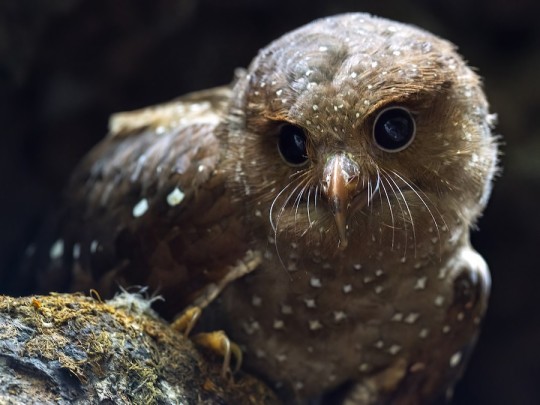
Tidbits of info, if you need help deciding:
Groove-billed Ani has flown in on the power of friendship and communal child-rearing- as well as the power of being "just a little guy". They're clumsy and floppy and cute and they do raise kids in a big communal family, which is wild for cuckoos to do.
Sickle-winged Nightjar have made it this far I think based solely on the fact they are nightjar that are just a little weird in the wings department. Nothing else about them is extra weird or strange, and they're not well studied.
Purple Honeycreeper defeated the Pink Robin, a bird which I thought was unstoppable, by a best 2-of-3 run-off poll. The male is pictured here, but the female is also quite colorful and could have been the contributing factor in the win.
Oilbird has risen on its popularity of being an absolute nut of a bird: it lives in caves and echolocates, it eats fruit but finds them mostly by vision, it is the only living member of its family and order, the babies are so fat they can be used to make lanterns-- it's a lot.
Image Sources: Ani (Cameron Carver); Nightjar (Kristof Zyskowski); Honeycreeper (Mike Hudson); Oilbird (Andres Vasquez Noboa)
#hipster bird main bracket#animal poll#bird poll#FINAL POLL#oilbird#purple honeycreeper#sickle winged nightjar#groove billed ani#south american birds. all of them#GBAN gets into north america but still
93 notes
·
View notes
Text
QUARTER-FINALS RUN-OFF!! 24 HOURS ONLY!!!
African Penguin vs Yellow-billed Magpie


Endangered vs Vulnerable! Donkey-honker vs corvid-squawker! A warm water fisher vs California endemic!
Image Sources: Penguins (Eric VanderWerf); Magpie (Andrew Spencer)
#hipster bird main bracket#run-off poll#quarterfinals#bird polls#african penguin#yellow billed magpie#thats all the info yall get these run-offs were not made to be intense#and its going by the seat of my pants#fun fact: the poll glitched and had YBMA listed twice lol
92 notes
·
View notes
Text
Semifinals, Poll 7
Short-tailed Pygmy-tyrant vs Oriental Bay-Owl


sources under the cut
Short-tailed Pygmy-tyrant (Myiornis ecaudatus)
"Minute size and compact body give it a unique appearance, in some ways looking more like a bumblebee than a bird." - eBird
eBird sightings: 7,276; IUCN Redlist Rating: Least Concern
This species is the smallest songbird, and one of the smallest birds in general. Typical weight is 4.2 g - when compared to some hummingbirds, which weigh 3.0 g at their heaviest. So many descriptions of this bird say that it seems to resemble a beetle or bee rather than a bird, and that it's calls and song sound more like crickets or frogs.
Oriental Bay-Owl (Phodilus badius)
"In breeding season, once described as surpassing all other owls in [the] appalling nature of its cries, even sounding like half a dozen cats fighting." - Birds of the World
eBird sightings: 1,292; IUCN Redlist Rating: Least Concern
This owl is a generalist species, feeding on small rodents, bats, birds, snakes, frogs, lizards and various insects such as beetles, grasshoppers, and spiders. Their short, rounded wings help them to navigate their habitat, allowing them to quickly and quietly bank through tight trees and other vegetation to capture their prey.
Images: Flycatcher (Henry Cook); Owl (Wich'yanan Limparungpatthanakij)
#aka: smol#hipster bird main bracket#polls#short tailed pygmy tyrant#oriental bay owl#passeriformes#strigiformes
53 notes
·
View notes
Text
Round 3, Poll 12
Red-crested Turaco vs Palawan Peacock-pheasant


sources under cut
Red-crested Turaco
eBird Sightings - 106
IUCN Status - Least Concern
Location: Africa - Northwest Angola
“looks like a mango”
Palawan Peacock-pheasant
eBird Sightings - 323
IUCN Status - Vulnerable
Location: Philippines - Palawan Island
“Males are strikingly indigo, they have multiple spurs, and they stridulate using quills!”
Images: Turaco (Dubi Shapiro); Pheasant (Bruce Wedderburn)
Stats pulled from Birds of the World
#hipster bird main bracket#round 3#quarterfinals#bird poll#animal poll#red crested turaco#palawan peacock pheasant
48 notes
·
View notes
Text
Semifinals, Poll 8
Bat Hawk vs Groove-billed Ani


sources under the cut
Bat Hawk (Macheiramphus alcinus)
"Bats are captured by the use of small talons and swallowed whole immediately in flight." - Wikipedia
eBird sightings: 3,086; IUCN Redlist Rating: Least Concern
Other than bats, this hawk will also hunt swallows, swifts, nightjar, and sometimes insects. Almost 50% of their hunts are successful. Their gape, or mouth opening, is the largest of any raptor relative to body size, and is ironically more similar to that of swallows and nightjar. This may be due to their habit of eating on the wing, or as a selective pressure to a limited feeding time- only around 30 minutes at dusk.
Groove-billed Ani (Crotophaga sulcirostris)
"Bizarre, coal-black cuckoos with long floppy tails and unique, curiously tall, flattened bills. Gregarious and not particularly graceful; usually seen crashing around awkwardly in small groups" - eBird
eBird sightings: 262,392; IUCN Redlist Rating: Least Concern
Ani are communal nesters, with each pair creating their own nest before the group as a whole decides which single nest to lay all of their eggs in. Each member will take care of the chicks as if they're their own, and they all take turns incubating. While their genus name 'Crotophaga' means "tick-eater", it was given to them a bit erroneously. Rather than plucking ticks off of animals, as people have assumed, it's more likely the Ani prefer to follow cattle and other grazing animals because of the bugs they scare up.
Images: Hawk (Zak Pohlen); Ani (Cameron Carver)
(the tick story comes from their genus page, Crotophaga)
#aka: I did not exactly expect y'all to get this far but Lets Gooooo!#hipster bird main bracket#polls#bat hawk#groove billed ani
47 notes
·
View notes
Text
Congratulations: Oilbird!


With a resounding win at nearly 40% of the votes, our beloved Oilbird!
Second Place: Sickle-winged Nightjar
Third Place: Groove-billed Ani
Fourth Place: Purple Honeycreeper
Ironically, it turns out the run-off poll may not have been needed. Sickle-winged nightjar pulled ahead in the main poll as well around the same time that went live. Maybe it brought in some more attention? Who knows lol
Thank you everyone for participating in this poll! I can't believe how long it too, from the start of July until now, the end of October. I had a blast researching these birds, and hopefully you enjoyed the showdown!
#hipster bird main bracket#main bracket winner#bracket winner#I'm so proud of you Oilbird!!#truly a niche bird#(also keep an eye out for Nov. 1st)
48 notes
·
View notes
Text
Round 3, Poll 13
Wedge-tailed Eagle vs Short-tailed Pygmy-tyrant
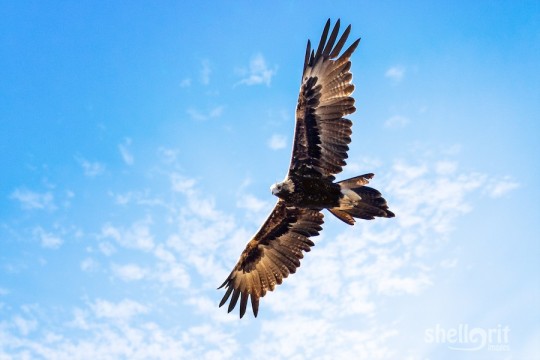

sources under cut
Wedge-tailed Eagle
“they’re friggin’ huge, they can have a wingspan of over 9 feet, I’m always just completely in awe when I see them. also, great legs.”
As a true generalist, anything is on the menu for this eagle. They seem to prefer mammals, especially the invasive European rabbit, but will also hunt native marsupials, including larger macropods (kangaroo). Because of this wide diet they’ve got a range that encompasses all of Australia and Tasmania.
Wedge-tailed Eagle have been noted to attack hang gliders and paragliders, though they are mostly targeting the sail itself and not the human. They’ve also been known to attack unmanned aerial vehicles used for survey operations. This is likely territorial defense, with the eagles mistaking these objects as another eagle.
Short-tailed Pygmy-tyrant
“small. hilarious name-bird combo”
“the smallest bird in the world after several species of hummingbirds. Naming this beast a "tyrant” is the funniest thing ever. Also I’m tail-shaming it" (for reference: tyrant refers to the family this bird belongs to- tyrant flycatchers, which are named after kingbirds)
“Although its plumage is similar to some other tyrant flycatchers, in the field the bird is more often mistaken for a large beetle or insect, especially while in flight… Its flight movements have a mechanical-feel that enhances the insect comparison.” - Wiki
Images: Eagle (Luke Shelley); Flycatcher (Anselmo d'Affonseca)
#hipster bird main bracket#round 3#quarterfinals#bird poll#animal poll#Wedge-tailed Eagle#Short-tailed Pygmy-tyrant
44 notes
·
View notes
Text
Round 1, Poll 16
Lesser Roadrunner vs Toulouse Goose


sources under cut
Lesser Roadrunner Propaganda
The scientific name Geococcyx velox means "swift earth-cuckoo", and it shares this genus with its sister species, the Greater Roadrunner. Their range overlap slightly, but the Lesser Roadrunner is found in Mesoamerica, along the southern edge of the region. There is one disjunct population at the north end of the Yucatan peninsula.
"Roadrunners bask in the early morning, on a fence post or bush. They cock their tail and droop their wings, then turn their back towards the sun, raising the scapular feathers and exposing their black skin which absorbs heat."
Toulouse Goose Propaganda
[submitted as: my goose Brenda] "I think it'd be really funny if he got to compete, I know geese are probably a common submission but I'm only submitting Brenda"
Greylag Geese are the ancestor of many domestic goose breeds, including the Toulouse Goose. This goose is named after the Toulouse, France, where it was bred. They often have a heavy dewlap, but sometimes that trait can be more reduced.
I don't know really anything about geese classification but the way it looks on Wikipedia says: "heavy goose. yes. geese: heavy" and I enjoy that.
Originally bred as a fast-growing goose reared for meat and goose fat, they are considered to be a placid and approachable breed for beginners. Often they are kept for egg production on small farms.
Image Sources: Roadrunner (Luke Seitz); Brenda (Brenda's owner)
54 notes
·
View notes
Text
Round 1, Poll 15
Blue Nuthatch vs Common Ground Dove


sources under cut
Blue Nuthatch Propaganda
"Cuties!! I see nuthatches depicted decently often, but never this guy!"
No other nuthatch is patterned quite like this guy! While most nuthatch have a combination of steel blue, white, and rusty rufous feathers, the Blue Nuthatch is the only one to sport a full mask.
Also unique to this species is the ability to protect its eyes by contracting the bare skin around them to help cover them up.
Common Ground Dove Propaganda
"THIS is the ultimate small pigeon. so you look at its photo and looks round and pigeon-like and you think oh okay i guess it's one of the normal species of pigeon, WRONg. google how it looks like when someone holds it in their hand. you would not BELIEVE how impossibly TINY this thing is and i want to hold it so so so badly it has no right to be this smol"
"When males compete for food or mates they may make sharp cooing calls and raise one or both wings, revealing chestnut wing-patches. A courting male follows the female and keeps doing this, sometimes flying after her to stay near."
Their song is often described as sounding like "No Hope"
Image Sources: Nuthatch (Neoh Hor Kee)
67 notes
·
View notes
Text
Semifinals, Poll 6
Whiskered Auklet vs Palawan Peacock-pheasant

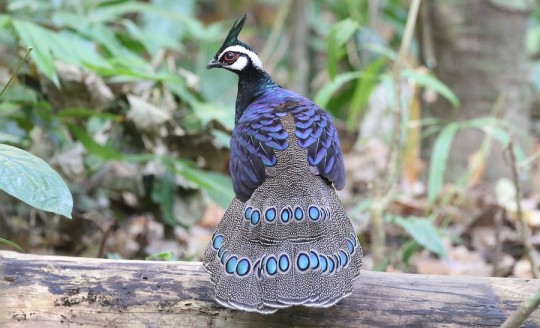

sources under the cut
Whiskered Auklet (Aethia pygmaea)
"An odd characteristic of this bird, which is also shared with the crested auklet, is that its plumage smells of citrus" - Wikipedia
eBird sightings: 576; IUCN Redlist Rating: Least Concern
Unlike most alcids, Whiskered Auklets stay at their breeding islands and roost on land year-round. They are the second smallest auklets, which is why their species name is 'pygmaea'. Whiskered Auklets feed on copepods (small crustaceans), and switch to krill in the fall and winter.
Palawan Peacock-pheasant (Polypectron napoleonis)
"The male Palawan excavates slight depressions in which [he] orients [his] body during postural display behaviors. The bird vibrates loudly via stridulation of rectrice quills." - Wikipedia
eBird sightings: 327; IUCN Redlist Rating: Vulnerable
All peacock-pheasant have multiple spurs, with this species having two on each leg. The spurs are used for anti-predator defense, foraging in leaf litter, as well as contests between males. Unlike many pheasants, the clutch size of this species is very small, only two eggs a year. This is likely due to the invested care from both parents, rearing the chicks together for up to two years.
Images: Auklet (Paul Jones); Peacock-pheasant (male - Brendan Ryan; female - Forest Botial-Jarvis)
#aka: island endemics (sorta)#hipster bird main bracket#whiskered auklet#palawan peacock pheasant#polls#oh also: retrice - tail feathers#charadriiformes#galliformes
38 notes
·
View notes
Text
Semifinals, Poll 5
White-tailed Ptarmigan vs Sickle-winged Nightjar


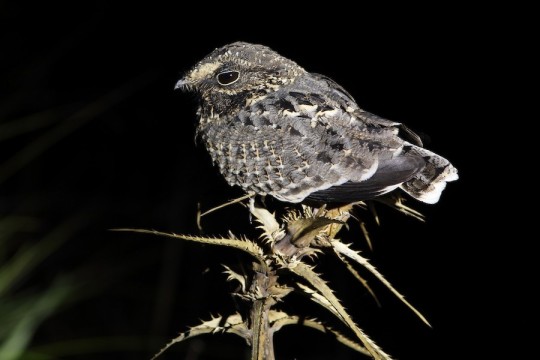
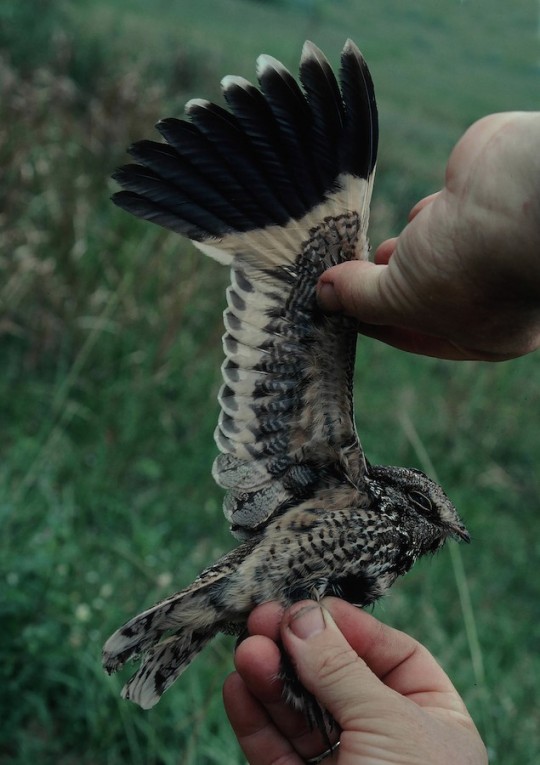
sources under the cut
White-tailed Ptarmigan (Lagopus leucura)
Lagopus is derived from Ancient Greek, meaning "hare foot". This is due to the heavily feathered legs and feet of ptarmigan.
eBird sightings: 5,809; IUCN Redlist Rating: Least Concern
Also known as the Snow Quail, this is the smallest bird in the grouse family. It serves as an indicator species for alpine tundra, and thankfully continues to fill a large range of western North America. The English name "ptarmigan" is Scottish Gaelic in origin, with 'tarmachan' meaning "croaker", referring to the bird's frog-like call. The p- was added due to a mistaken belief the word was Greek in origin, with the thinking being that the word related to 'pteron', "wing".
Sickle-winged Nightjar (Eleothreptus anomalus)
Eleothreptus, from Ancient Greek, means "marsh bred"
eBird sightings: 267; IUCN Redlist Rating: Vulnerable
There is not a lot of information on this bird, as nightjar are already cryptic and the common distribution of this bird hasn't been fully studied. They're currently found in northeastern Argentina, southern Paraguay, and southern Brazil. The Sickle-winged Nightjar shares its genus with a single other nightjar, which is also sparsely distributed across South America.
Images: Ptarmigan (summer - Garrett Hughes, winter - Josiah Verbrugge); Nightjar (wing - Kristof Zyskowski, body - Martjan Lammertink)
#aka: actually idk what thread is in common between these two. they're cute tho#hipster bird main bracket#white tailed ptarmigan#sickle winged nightjar#polls#caprimulgiformes#galliformes
36 notes
·
View notes
Text
Semi-Finals!
American Dipper vs Blakiston's Fish Owl
Oilbird vs African Penguin
Purple Honeycreeper vs Bluethroat
Japanese Paradise Flycatcher vs Pink Robin
White-tailed Ptarmigan vs Sickle-winged Nightjar
Whiskered Auklet vs Palawan Peacock-pheasant
Short-tailed Pygmy Tyrant vs Oriental Bay-Owl
Bat Hawk vs Groove-billed Ani
This post will be updated with poll links once they go live!
#hipster bird main bracket#masterpost#yall we are down to 8!!!#i was supposed to make use of my rain day and start on these polls but as of yet Ive just been playing Flight Rising lol
46 notes
·
View notes
Text
Semifinals, Poll 2
Oilbird vs African Penguin
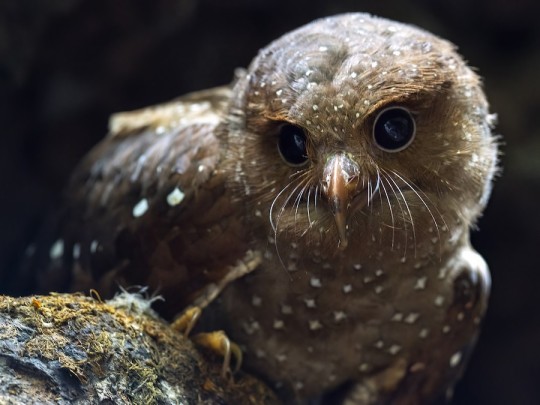
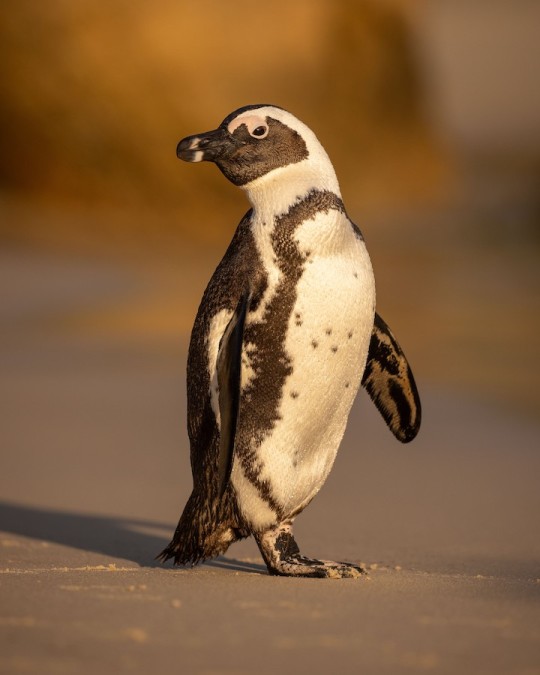
sources under cut
Oilbird (Steatornis caripensis)
"They are the only nocturnal flying fruit-eating birds in the world (the kakapo, also nocturnal, is flightless)" - Wikipedia
eBird sightings: 3,559; IUCN Redlist Rating: Least Concern
What more can I say? Why do they echolocate if they have such good eyes? How does it help with finding and eating fruit? The genus, family, and order name (Steatornis) means "fat bird", in reference to the fatness of the chicks. Apparently there have been fossils of this family found worldwide, but the oilbird is the only survivor, living in northwest South America. Their habitat ranges from lowland to subtropical forests in the Andes, so long as caves and forests with fruiting palms and laurels are nearby.
African Penguin (Spheniscus demersus)
"These guys are such funny bastards. They're like horny toddlers. They loaf. They crave violence. They can swim faster than Michael Phelps." - original poll propaganda
eBird sightings: 3,034; IUCN Redlist Rating: Endangered
Penguins are unable to swim during their molt, as their feathers are not yet waterproof. African penguins typically take three weeks to fully molt and must fast, surviving off of fat reserves; they will lose up to half of their body weight during that time. They will live at sea for most of their lives (10-25 years), coming to land when it is time to lay their eggs. Oh also they're called Jackass Penguins because they bray like donkeys.
Images: Oilbird (Andres Vasquez Noboa); Penguin (Dorian Anderson)
#aka: colonial birds that are too cute for their own good#hipster bird main bracket#polls#oilbird#african penguin#steatornithiformes#sphenisciformes
34 notes
·
View notes
Text
Main Brackets!
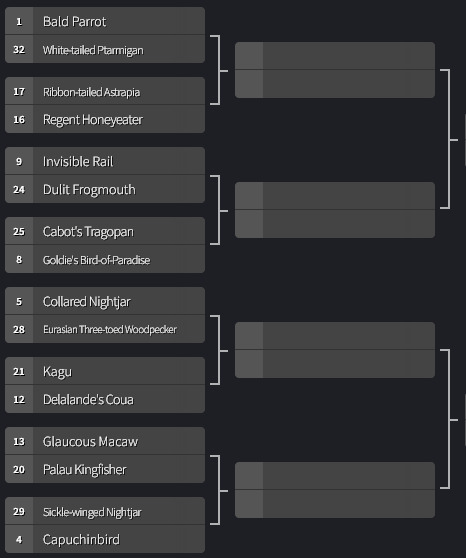
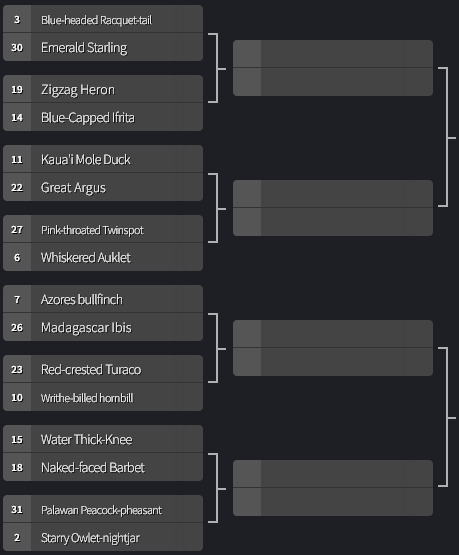

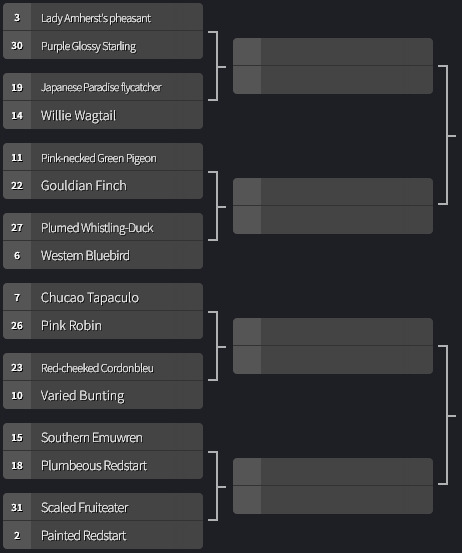
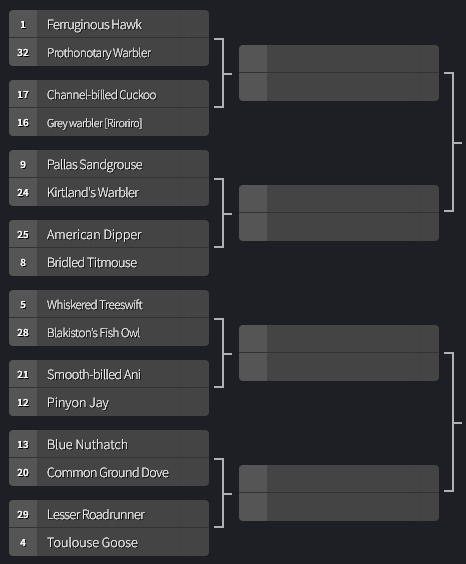


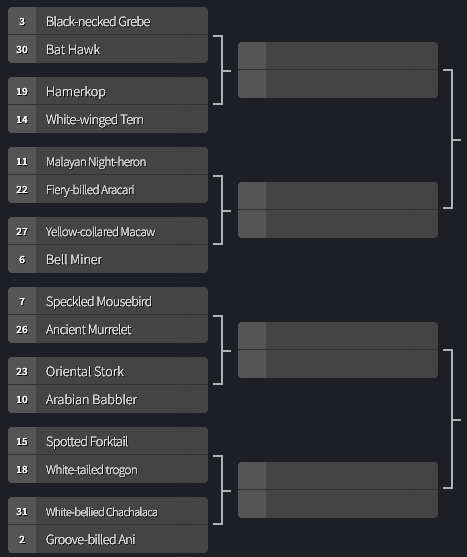
There are four brackets [Fave, Pretty, True, Four] comprising of 32 birds, for a total of 128 birds in this poll! I will reblog a version of this post with every bird listed via text within their bracket, so it is easier to find for those with image issues. It's gonna take a while to actually put the posts together for the first round, seeing as there are 64 battles happening, so expect the polls to go up around July 12th.
Below is a link for submitting any cool facts or info about the birds you want to win. It's not necessary to send info here, but I like to give the option to infodump about birds, and it helps with keeping things organized.
As per tumblr etiquette, you are totally free to reblog the polls themselves with as much propoganda as you want. These submissions are just to help me fill the poll post with some cool facts.
EDIT: for mobile users, this post has all the tags for the round 1 brackets, in place of having another masterpost. Everything is tagged with #Hipster Bird Main Bracket or its corresponding #Bracket: TYPE A style tag. Once we move on there shall be a new post.
#information#Hipster Bird Poll#submission form#Hipster Bird Main Bracket#I also did this so my inbox will maybe be a little more clear still#and this makes the info easier to sort through! I can just CtrlF and find the birds and organize the facts that way#bracket: fave a#bracket: fave b#bracket: pretty a#bracket: pretty b#bracket: true a#bracket: true b#bracket: four a#bracket: four b#round 1
54 notes
·
View notes
Text
Round 3, Poll 15
Bat Hawk vs Fiery-billed Aracari
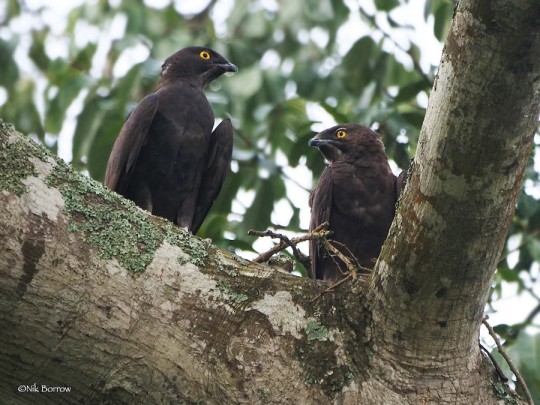
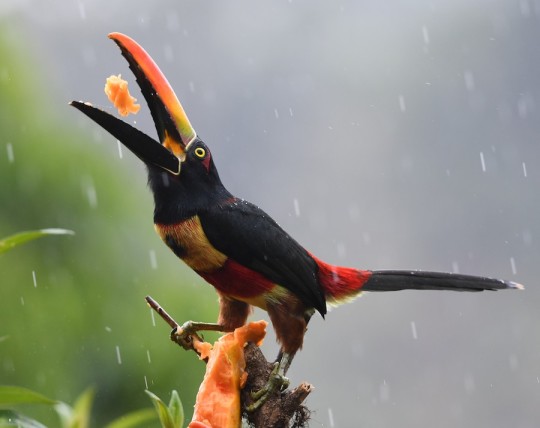
sources under cut
Bat Hawk
“Catches bats in flight and swallows them whole”
Bat Hawk will also capture swallows, swifts, and nightjars to supplement their diet of bats. Almost half of their hunts are successful!
The reason they eat on the wing is that they only really have around 30 minutes to hunt every day. This is also the theory as to why their mouths are so wide- bat hawks have the largest gape to body size ratio of any raptor, seeming almost like a nightjar instead.
Fiery-billed Aracari
These birds typically travel in groups of six or more, groups that sometimes include other toucans. They roost communally, and may pack several birds into the same cavity for sleeping.
A cooperative breeder, sometimes birds from the previous season will return to aid their parents in raising the next brood. While the diet of adult aracari is mostly fruit based, they’ll feed the nestlings mostly insects.
Images: Hawk (Nik Borrow); Aracari (Joshua Vandermeulen)
Birds of the World: both speices
#hipster bird main bracket#round 3#quarterfinals#bird poll#animal poll#bat hawk#fiery-billed aracari#nothing against Aracari but I'm still surprised it beat Bell Miner
40 notes
·
View notes
Text
Round 2, Poll 26
Fiery-billed Aracari vs Bell Miner
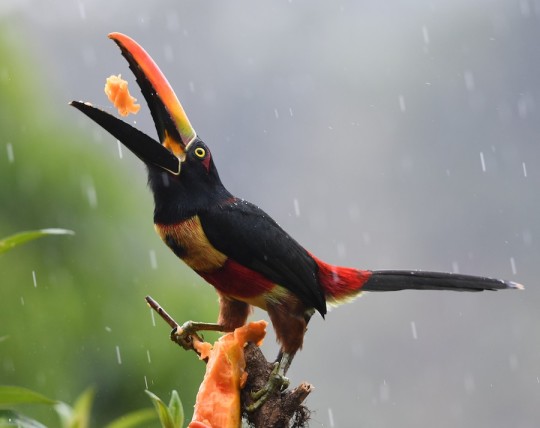
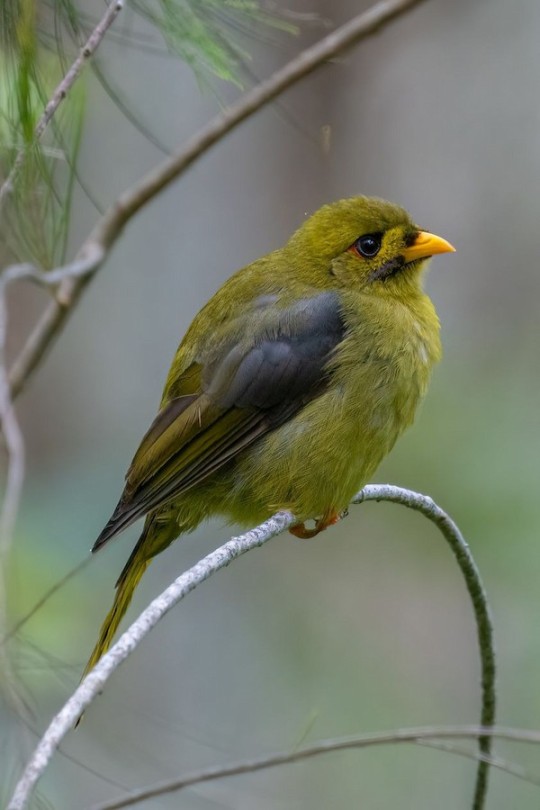
sources under cut
Fiery-billed Aracari
These birds typically travel in groups of six or more, groups that sometimes include other toucans. They roost communally, and may pack several birds into the same cavity for sleeping.
A cooperative breeder, sometimes birds from the previous season will return to aid their parents in raising the next brood. While the diet of adult aracari is mostly fruit based, they’ll feed the nestlings mostly insects.
Bell Miner
“Their call is such a relaxing tinkling from the tall trees. But also, more importantly, they’re like the saddest looking birds I’ve ever seen. Like who hurt you, buddy.”
Bell miners live in large, complex social groups. Within each group there are subgroups containing several breeding pairs, but also a number of birds not currently breeding. Non-breeding birds will aid in the raising of the nest. These birds defend their colony areas communally and aggressively, excluding most other passerine species, which would compete with the miners on their main source of food: colonies of psyllid bugs called “bell lerps”.
"bell miner are a problem because of how well they protect their psyllid bugs. They lead to trees dying- it's called Bell Miner Associated Dieback, or BMAD (which is a great acronym). But eucalyptus forests are already struggling in a lot of places because of the changes in the fire regime. we need more fire, but BMAD also adds to those issues in some areas! I don't hold it against them tho, look how sad they are"
Images: Aracari (Joshua Vandermeulen); Miner (Bernadett Kery)
Birds of the World: Fiery-billed Aracari
#hipster bird main bracket#round 2#bracket: FOUR a#fiery billed aracari#bell miner#ramphastidae#meliphagidae
42 notes
·
View notes